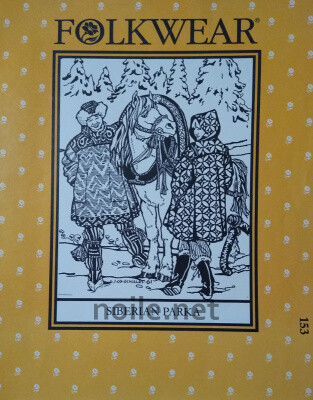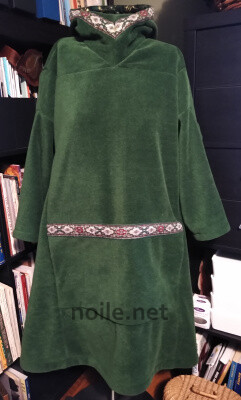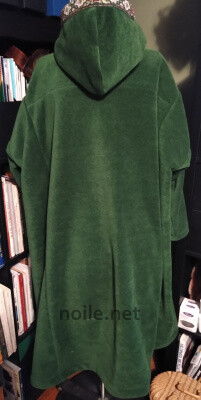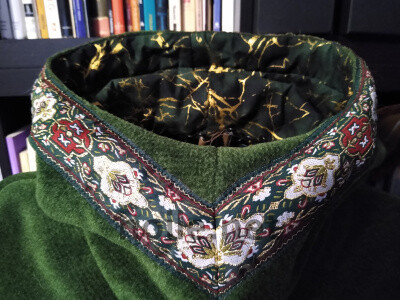It’s winter, it’s Covid, it’s time to huddle, and wearable blankets, otherwise known as “ponchos”, are everywhere, and mostly meh and so large as to be unmanageable. Like a lot of people now, I, too, want to hibernate until it’s all over — define “all” however you like — so obviously I needed a day wear blanket.

Years ago I made Folkwear’s Siberian Parka, a marvelous garment better suited to the Frozen North than to suburban life in more temperate climes. When casting about for something more interesting to make than a rectangular covering with a hole cut for the head, Folkwear 153 naturally came to mind.
I had yards of a surprisingly lovely fleece in stash. I bought it at the old Norristown, Pennsylvania Jomar (now long-gone), and I’m pretty sure it came originally from Malden Mills. I won’t buy polyester fleece now, but ten years ago, Malden Mills represented a kind of gold standard, and this fabric has a nice, soft, hand, which has not diminished while it lived in stash.

Covid sheltering has made me impatient, so I made the same changes to the paattern that I had done for the previous garment: I combined the two sleeve parts into one, and also combined the pieced yokes into single pieces. Then, because even impatience can’t keep me from complicating things, I pulled yards and yards of ridiculously elaborate trim from stash (what was I thinking when I bought it?!?), and set about spiffing up my wearable blanket.
This was more complicated than I realized. Instead of using the (rather nice) Folkwear pockets, I made a large patch pocket across the front. I soon realized that the easiest way to trim the parka was simply to run the decor up along the side front and back seams — and just as quickly I realized that I’d hate feeling the trim every time I reached into a pocket. What ensued was a lot of fiddling to get the trim attached to the pocket sides before applying it to the rest of the front and back. This was a pain.

There’s nothing fiddly about the construction of the garment body. If you can resist the temptation to complicate things, it’s an easy, quick project to sew: The body is all straight lines. The hood is a joy, beautifully curved around the face, and neatly joined to the yokes. Like the parka body, the hood is unlined, but I chose to line mine, since I knew I was asking for trouble if my long hair and fleece interacted much. The lining, cotton quilting fabric, also from stash, came from Hayes, in Wilmington, Delaware, and, with its gold streaks, seemed appropriately flash for a garment that began to look as if it wanted to grow up to be a medieval court robe.

This time around I made the XS, which was the right call. My previous version was the larger Small; since it was made from thicker, more unyielding, upholstery fabric with a thin fleece lining, the larger size was a better choice for it. This is a roomy garment! But for this iteration, “wearable blanket” meant I needed to be able to move around — you know, when absolutely necessary (biscuits are downstairs, after all) — so the smaller size was definitely the best choice.

I have not made the Siberian parka yet. I have been toying with the idea of making it from double-sided quilted nylon taffeta that I found on sale. It’s a flashy watermelon red/pink color that I like a lot. It is stiff-ish material. Do you think the parka would work in this?
I think it would be great! Also a lot more practical than my version, and lighter weight. Go for it!